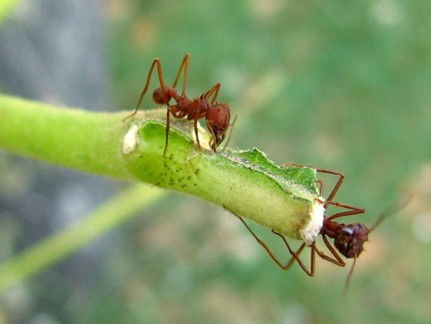by Bee Harris, PWL Member

Leaf Cutter ants (multiple species) are the dominant herbivores of the Americas’ tropics. The Texas Leaf Cutter ants (Atta texana –Buckley) are unpopular with farmers and gardeners in Texas and Louisiana. They are one of two highly destructive plant insects; the other being the southern pine beetle (1981). Leaf Cutters live in large colonies with as many as two million ants. They can strip plants of leaves and other plant parts overnight destroying landscape foliage, vegetable gardens, and agriculture. A large enough colony can cause great monetary losses to farmers. Control options are few. Insecticides have been developed to kill the leaf cutter ant, but they aren’t safe to use on crop farms, agriculture, or pastures
Texas Leaf Cutter ants do not eat the plant parts they have harvested. They use them to grow underground fungus gardens. The size of their colonies and fungus being their only food source, makes it difficult to eradicate the ants. The main predator of the Leaf Cutter is the Phorid fly which lays its eggs on the ants as they forage. When the fly’s eggs hatch, they feeds on the ant. Perhaps in the future, Phorid flies will be used to combat this destructive ant.
These ants vary in size from 1/16” to ½” with the queens being ¾ inches. Their color is from light rust to dark brown. Their size variety and color range can make it difficult to identify them unless you spy the six spines on their backs and two on the back of their heads.

Colonies have multiple queens. Their mating takes place while in flight on clear nights during the phase of a new moon from April through June. Before mating, the queen prepares herself by packing a small crevasse in her mouth with pieces of live fungus. Once the mating ends, males die and the queen searches for a place to establish a new nest. She digs a small hole in the soil and places the fungus from her mouth in the soil to cultivate it for egg laying purposes. Incredibly, she will eat most of the eggs she lays and use her feces, as garden manure, to feed the fungus. The remaining eggs hatch into larvae. The larvae grow into worker ants with the mission to bring back plant fragments for growing fungus in the new nest. Most foraging activity is at night in the summer and during clear days the rest of the year if temperatures are in the 45F – 80F degree range.
Texas Leaf Cutter ants create crater shaped mounds for their colonies. These can be incredibly large if the conditions are right for growth. Their nests can be as deep as 20 feet and perforate the ground with chambers and lateral tunnels (up to 500 feet in length). These can weaken the ground and cause sink holes when heavy machinery travels over it.
These ants prefer woody plants as food for their fungus. Their multi-generational fungus farms can be affected by disease; however, the ants protect their fungus from the environment by tending them underground, watching over the fungus closely to stop diseases early, and managing multiple microbes that can control diseases. The results of their farming and expansive nests, enrich the soil. On a small scale, Leaf Cutter ants’ pruning of vegetation stimulates plant growth and has positive effects on forest structure.
For more information:
Mueller, U.G., et al. (2005). The Evolution of Agriculture in Insects https://www.annualreviews.org/content/journals/10.1146/annurev.ecolsys.36.102003.152626
Texas A&M Forest Service. Forest Health; Leaf-Cutting Ant
https://tfsweb.tamu.edu/LeafCuttingAnt
Steven Richardson, Forest Huval, C. Carlton, T.E. Reagan. LSU AgCenter. Atta texana, Texas Leaf Cutter Ant (Hymenoptera: Formicidae), https://www.lsuagcenter.com/articles/page1649168993168


